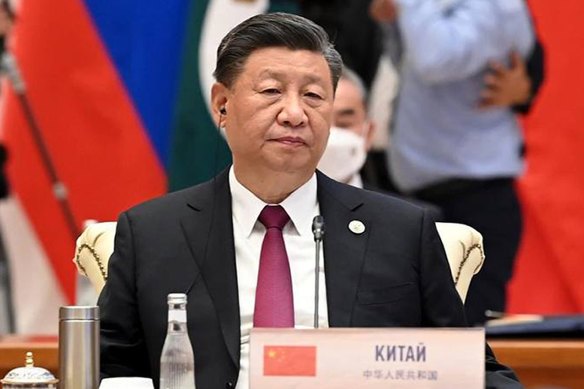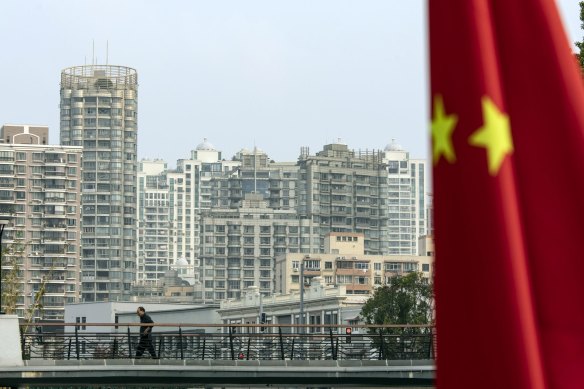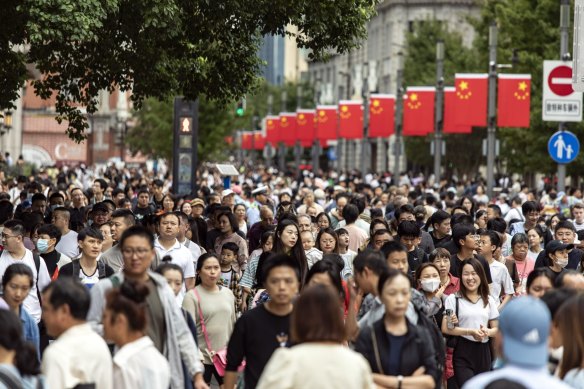This was published 1 year ago
Opinion
The clock is ticking as China spirals
Stephen Bartholomeusz
Senior business columnistChina’s attempts to stabilise its deeply troubled property sector are likely to ramp up this year, with a record reduction in its key mortgage rate this week likely to be only the start of a more aggressive policy push.
Tuesday’s 25 basis-point cut to the five-year loan prime rate, from 4.2 per cent to 3.95 per cent, was the first since a 10 basis-point reduction in June last year. It clears the way for another reduction in the minimum mortgage rates for homebuyers in an attempt to stimulate demand in a market where sales and prices have been falling continuously for the past three years.

The list of challenges facing Xi Jinping and China is growing. Credit: AP
By itself the move is probably too little, too late, given the degree of damage to the sector and consumer confidence has already been done.
Previous attempts to relieve some of the stresses on developers – making more and cheaper credit available to the more viable developers to try to complete some of the millions of uncompleted or undeveloped apartment that were pre-sold to buyers and relaxing some loan requirements for prospective buyers – have also been incremental and have failed to have any significant effect.
With 90 per cent of Chinese households owning their own homes and about 70 per cent of household wealth attributable to housing, the damage to China’s household finances and confidence wrought by the implosion of the sector has led to a growth-threatening deflationary spiral.
In BHP’s latest Global Outlook this week, it estimated that excess household savings amount to around $US2.6 trillion (about $4 trillion), or 17 per cent of China’s gross domestic product. That’s an extraordinary indicator of how anxious and defensive ordinary Chinese are.
The meltdown in China’s sharemarkets – shares in the mainland markets have fallen more than 40 per cent over the past three years – hasn’t helped, nor have the other losses of household wealth that have occurred within China’s shadow banking sector. It’s not surprising that shell-shocked households have battened down their hatches.
The mortgage rate cut followed a 1 billion yuan ($212 million) injection of liquidity by the People’s Bank of China into the financial system at the weekend, suggesting that the Beijing authorities are shifting towards looser monetary policies in a fresh attempt to boost consumer confidence and spending.
With the National People’s Congress scheduled for early next month, it is probable that the cut to mortgage rates will be followed up with a broader effort to turn the property market around.
One obvious strategy in the state-controlled economy, which might already be underway, is for the central government (and to the extent that they have the financial capacity, local and regional governments) could play a much greater role in the market.

Beijing is confronted with a range of challenges beyond the property crisis, but this is its biggest and most complex one.Credit: Bloomberg
There have been suggestions – borne out by state-owned entities now having displaced private sector developers as the largest buyers and sellers of land – that the state will acquire some of the distressed property projects at distressed prices, complete them and then rent or sell them to low and middle income buyers as state-subsidised housing.
That policy envisages a far greater role for the state in property than has been the case during the decades of China’s property boom.
That boom was led by the private sector and developed into a speculative bubble that has ravaged the developers and those who, because of the pre-sales model the industry operated on, were left with mortgages but incomplete properties or developments where construction hasn’t even started.
A shift towards much deeper state involvement in the sector would fit with President Xi Jinping’s conviction that “houses are for living in, not for speculation,” a conviction that led to the “three red lines” restrictions on leverage in 2020 that triggered the collapses of the developers.
A challenge for the policymakers is the glut of housing – the millions of apartments already empty and the latent capacity additions if incomplete developments were completed – but that excess capacity has to be dealt with if the market is to be stabilised.
Subsidised rentals to low-income households might be costly, given the scale of the problem, but it might be the only realistic way to respond, particularly in regions away from the major urban areas, where the continuing urban drift will eventually help absorb the excess housing stock.
A concern, if the state does step in as the buyer of last resort for distressed property, is the impact it would have on China’s banks if the as-yet unrealised losses on their property lending were to be realised via forced sales to the state at distressed prices.
The property market is probably the most critical issue the national congress due to start on March 5 will have to wrestle with, although stabilising financial markets – halting the sharemarket rout and an exodus of foreign capital that resulted in the lowest levels of foreign direct investment last year in more than 30 years – will also presumably be high on the agenda.

China’s battered economy has crippled consumer confidence.Credit: Bloomberg
Apprehension about the impact on foreign investors may have deterred the People’s Bank of China from lowering its key policy rate, the one-year prime rate, along with the reduction in the five-year rate.
With US interest rates remaining high, the central bank would have been wary of widening the yield gaps and causing another weakening of an already-weakened yuan and a new burst of capital flight. A weaker yuan would make China’s exporters more competitive but that, too, could exacerbate an existing problem.
China’s factories have significant excess capacity and the threat of cheap Chinese goods being dumped into international markets has seen the US and the Europeans recently warning Beijing they will respond if there is a flood of China-manufactured products into their economies.
The European Union is already investigating China’s electric vehicle exports, in a probe focused on determining the extent of state and other subsidies. Other countries would probably launch similar investigations or retaliate via trade barriers if they were inundated with cheap imports.
Beijing is confronted with a range of challenges beyond the property crisis, albeit that it is its biggest and most complex one.
The sharemarket meltdown, stresses within its shadow banking system, the excess factory capacity, the exodus of foreign investment, the dearth of consumer confidence and therefore of domestic consumption will all need to be worked through to put China’s economy on a more stable and sustainable path and avoid a long term and destructive deflationary spiral into, at best, economic stagnation.
While there are no easy solutions to problems that have some structural elements to them, this is the year when China’s authorities will have to at least make some meaningful progress in tackling them.
The Business Briefing newsletter delivers major stories, exclusive coverage and expert opinion. Sign up to get it every weekday morning.